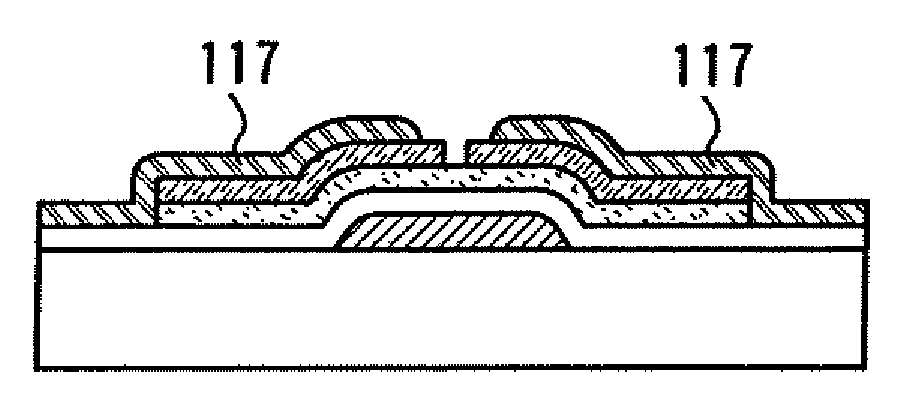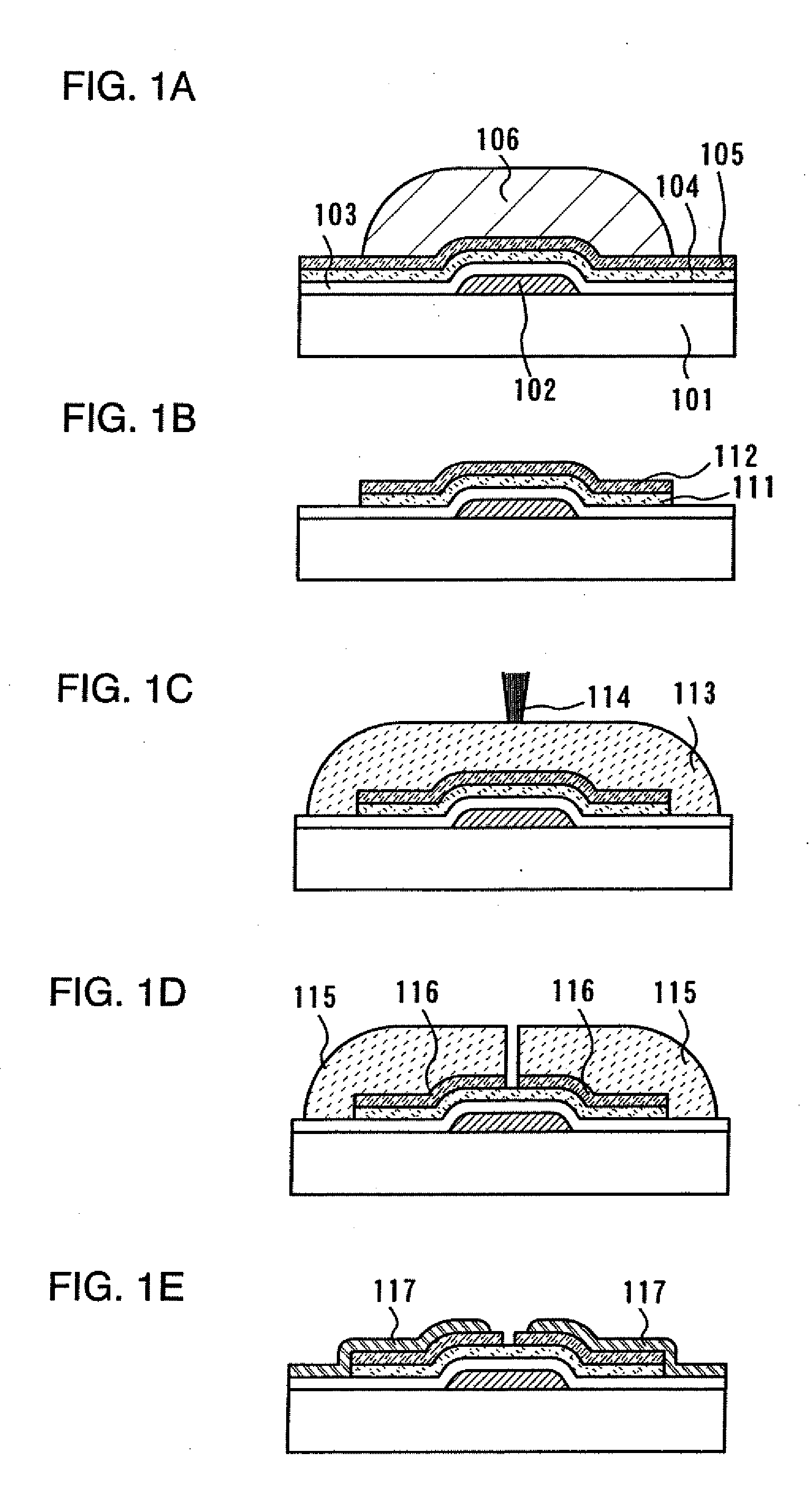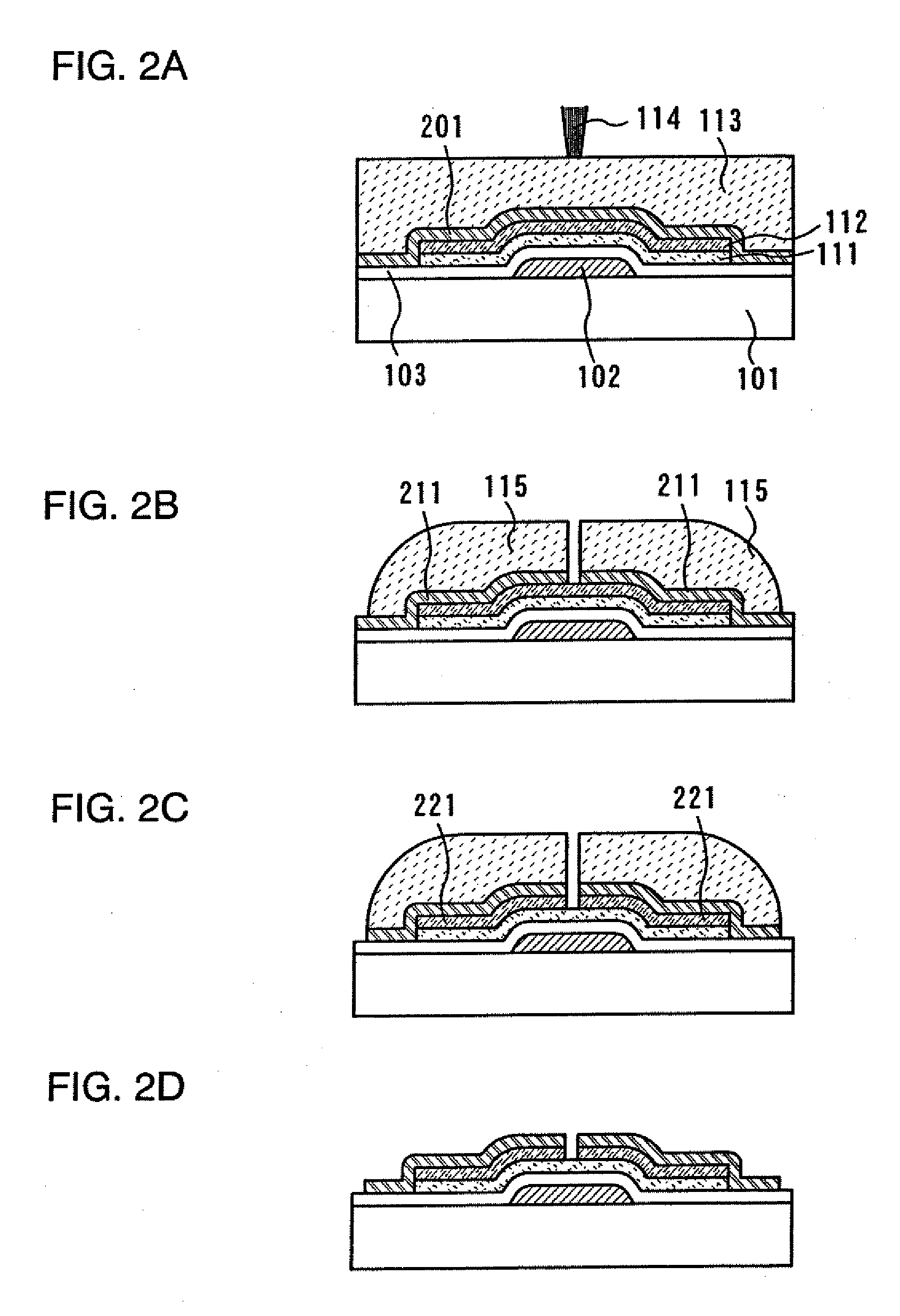Semiconductor device and manufacturing method thereof, liquid crystal television system, and el television system
a technology of semiconductor devices and manufacturing methods, applied in television systems, instruments, printing, etc., can solve the problems of increasing the area of tft, reducing the throughput of the forming process, and wasting the most of the materials of film patterns and resists, so as to achieve controllable thickness and width of the pattern to be formed, increase the w/l, and the effect of increasing the driving ability
- Summary
- Abstract
- Description
- Claims
- Application Information
AI Technical Summary
Benefits of technology
Problems solved by technology
Method used
Image
Examples
embodiment mode 1
[0079]In this embodiment mode, a process will be described with reference to FIGS. 1A to 1E, where a mask pattern that is formed by irradiation with a laser beam (hereinafter, also referred to as laser light) is used to form a TFT with a short channel length.
[0080]Specifically, a process for forming a channel etch type TFT, which is one of inverted-staggered TFTs, as a semiconductor element will be described in this embodiment.
[0081]As shown in FIG. 1A, a first conductive layer 102 is formed over a substrate 101. As a method for forming the first conductive layer 102, droplet discharge, printing, electrolytic plating, PVD, or CVD is used. For example, in the case of employing PVD or CVD, the first conductive layer 102 can be formed in such a way that a conductive layer is formed over the substrate 101, a photosensitive resin is formed thereon, the photosensitive resin is irradiated with laser light and developed to form a mask pattern, and then the conductive layer is etched into a ...
embodiment mode 2
[0130]In this embodiment mode, with reference to FIGS. 2A to 2D, a process for forming a channel etch type TFT as in Embodiment Mode 1 will be described. This embodiment mode is different from Embodiment Mode 1 in the process for manufacturing the source electrode and the drain electrode.
[0131]As shown in FIG. 2A, a first conductive layer 102, a first insulating layer 103, a first semiconductor region 111, and a second semiconductor region 112 are formed over a substrate 101 in the same way as in Embodiment Mode 1.
[0132]Next, a second conductive film 201 is formed on the second semiconductor region 112 and the first insulating film 103. The material and manufacturing process of the second conductive film 201 can be the same as those of the first conductive layer 102 in the Embodiment Mode 1.
[0133]Next, a photosensitive resin 113 is applied or discharged over the substrate, and then the photosensitive resin 113 is irradiated with laser light 114 for exposure in the same way as in Emb...
embodiment mode 3
[0137]In this embodiment mode, with reference to FIGS. 3A to 3E, a process for forming a channel etch type TFT with a short channel length by using a material forming a liquid-repellent surface will be described. In this embodiment mode, source and drain regions are formed by forming a mask pattern on a second semiconductor film that is conductive and etching the second semiconductor film with the use of this mask pattern.
[0138]As shown in FIG. 2A, a first conductive layer 102, a first insulating layer 103, and a first semiconductor film are formed over a substrate 101 in the same way as in Embodiment Mode 1. After that, a first semiconductor region 111 is formed by forming a first mask pattern 106 as shown in Embodiment Mode 1 and etching the first semiconductor film.
[0139]Next, a second semiconductor film 301 is formed on the first semiconductor region 111 and the first insulating film 103. The material and manufacturing method of the second semiconductor film 301 can be the same ...
PUM
| Property | Measurement | Unit |
|---|---|---|
| size | aaaaa | aaaaa |
| size | aaaaa | aaaaa |
| size | aaaaa | aaaaa |
Abstract
Description
Claims
Application Information
 Login to View More
Login to View More - R&D
- Intellectual Property
- Life Sciences
- Materials
- Tech Scout
- Unparalleled Data Quality
- Higher Quality Content
- 60% Fewer Hallucinations
Browse by: Latest US Patents, China's latest patents, Technical Efficacy Thesaurus, Application Domain, Technology Topic, Popular Technical Reports.
© 2025 PatSnap. All rights reserved.Legal|Privacy policy|Modern Slavery Act Transparency Statement|Sitemap|About US| Contact US: help@patsnap.com



